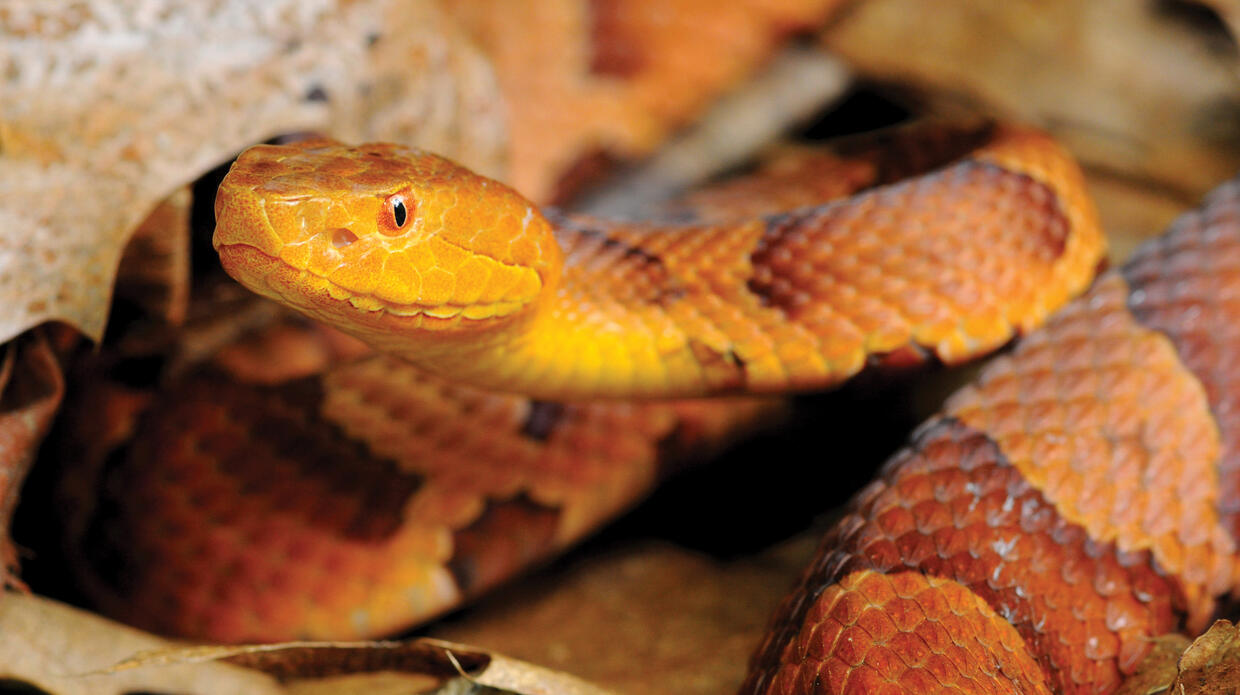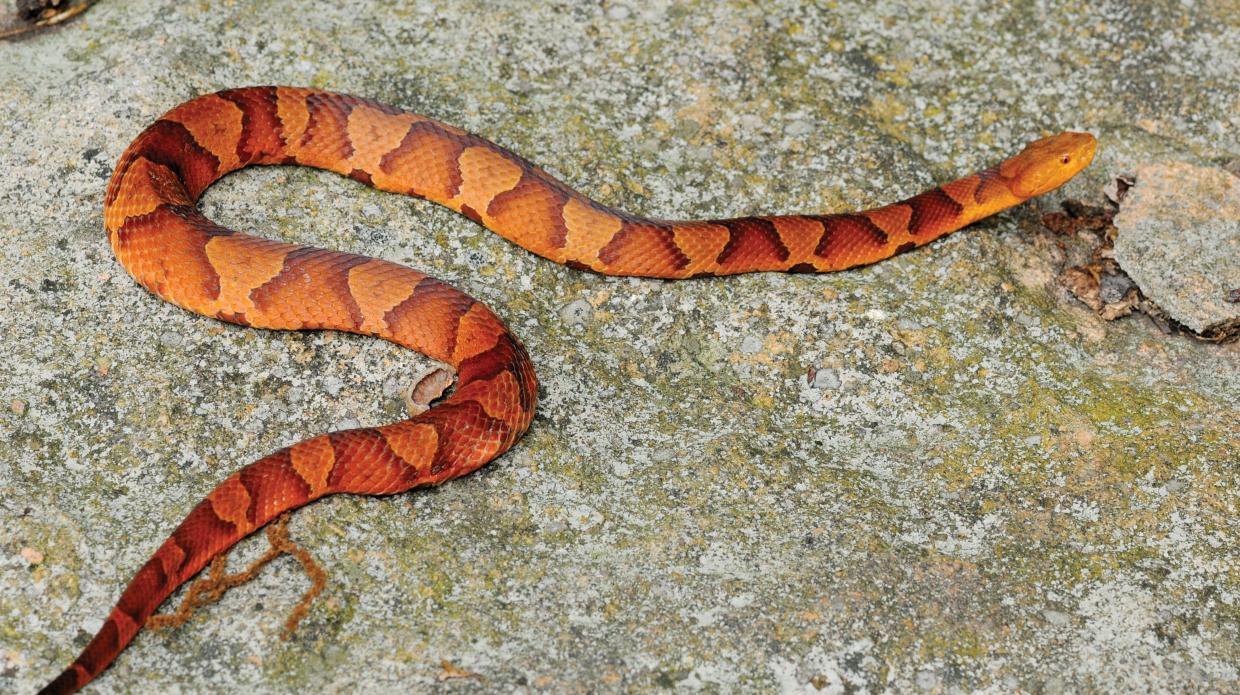Fast facts
Common name: Copperhead
Scientific name: Agkistrodon contortrix
Range in MA: Limited to small, localized populations in Norfolk and Hampden counties
Conservation status: Listed as endangered in Massachusetts
Fun fact: Named for their solid, relatively unmarked heads, which are similar to the color of an old copper coin
Similar species: Eastern milksnakes (much more common, not venomous), timber rattlesnake (the only other pit viper and venomous species in MA), northern watersnake (much more common, not venomous, darker colored, rarely seen away from water)
Identification tips: Compared to milksnakes, copperheads have distinctive hourglass patterns, and their bodies and their heads are much thicker
Description
Copperheads have broad, triangular heads and vertically elliptical pupils. Their bodies feature dark brown or reddish hourglass-shaped cross bands, which appear more narrow in the middle of the body and more broad on the sides. Belly colors ranges from beige to tan. They have weakly keeled scales (a ridge protrudes from the middle of each scale). Males usually have longer tails, but females can grow to greater total lengths. Adults range from 24–40+ inches.
Copperheads are members of the pit viper family. Sensitive nerve ends in their pits react to radiant heat, helping them find warm-blooded prey even in darkness. They can see well within a limited range, and they can see moving objects more easily than stationary ones. They can detect ground vibrations, which transmit to their auditory nerves through the bones of their lower jaws. Their tongues bring in particles from the air, and their "Jacobson’s organ" on the roof of their mouths aids in smelling.
Two large venom-conducting fangs are secured to the upper jawbone at the front of the mouth. They are movable and fold against the roof of the mouth when not in use. A fleshy sheath covers each fang when the mouth is closed. These fangs also shed periodically. Each socket develops replacement fangs, located in the gum behind the functional fang, and each fang is connected to a venom gland. In addition to their enlarged fangs, many curved smaller teeth are located on the palate and lower jaw. Though they are venomous, copperheads are not aggressive toward people.
If you see one
Because they are venomous and endangered in Massachusetts, please maintain a safe, respectful distance. Avoid trying to handle or otherwise disturb them.
To help with conservation efforts, please submit your observations with us. Either:
- create an account in the Heritage Hub, or
- complete and mail a Rare Animal Observation Form for one-time observations.
Your reports provide critical information that informs future habitat management and wildlife conservation for future generations.
Habitat
Massachusetts copperheads live in and around deciduous forests and prefer moist, damp habitats as well as traprock (basalt) ledges with extensive rock slides below. Some wintering dens (hibernacula) are on the edges of swamps, reservoirs, rivers, and streams. Den entrances have southern, southeastern, or southwestern exposures, allowing for access to more sun in spring and fall. Habitat often also includes stands of red cedar, pine, and hemlock, as well as cool, damp meadows. Summer grounds are located near wetlands, wooded swamps and marshes, or lakes and reservoirs. During this time, copperheads may also inhabit fields and meadows, wet woodlands, and quarries.
Unlike the timber rattlesnake, with which it commonly shares den sites, the copperhead is unlikely to have ever been widespread in Massachusetts.
Life history
Massachusetts copperheads are active from April to October. After emerging from hibernation, they spend their first few weeks basking on ledges during the day, often in the same spots and with other copperheads and other snakes nearby.
Copperheads mate in both spring and autumn. During mating seasons, males are especially active and are sometimes aggressive with other males. Courting males use their tongues to sense female pheromones in the air. They approach by moving their chins on the ground and trying to place their head on part of females' bodies. Females respond with tail movements: slow back-and-forth waving, rapid back-and-forth whipping, or extremely rapid tail vibration. Mating duration ranges from 3.5–8.5 hours.
After spring mating, most males and some females migrate up to two miles from their den sites. Females give birth to litters of up to a dozen 8–10 inch young from August to early October. At this time, females gather in birthing rookeries, either at their winter dens or sometimes up to a mile away from their dens. Each of the young is equipped with venom, fangs, and a supply of egg yolk for nourishment in their abdominal cavities. Copperheads reach sexual maturity at five years old and have estimated life spans of 18 years. Watch a copperhead birth caught on camera.
Copperheads mainly eat small mammals and frogs, but they also eat birds, insects, and other snakes. Young copperheads lure amphibians by wiggling the yellow tips of their tails. After they strike and inject venom, they track their prey by scent and safely consume them after having removed the threat of retaliation. During spring and autumn, when night temperatures are lower, copperheads hunt mainly by day. During summer, copperheads switch from to nocturnal hunting. This helps them avoid intense heat and increase their chances of success, as rodents and amphibians are more active at night.
Copperheads are rarely aggressive toward people. When approached they normally lie still or move slowly to conceal themselves. If they are threatened, they can move quickly, vibrate their tail rapidly, and strike repeatedly. Most copperhead bites occur when people step on or touch one accidentally. Bites require immediate medical attention. They are painful and can cause tissue damage, but they are not fatal.
Management and conservation
Without dedicated public and privately-managed lands, much of the remaining copperhead habitat would have already been destroyed. Increasing public holdings or conservation easements in prime habitats is critical for this species. Public education and law enforcement are additional key components to the long-term survival of in-state populations. Best practices also include:
- Reducing mortality on nearby roads
- Protecting known denning colonies
- Protecting location information of den sites
- Providing biologically accurate information in public education
- Working with local residents to promote understanding and support
- Professional patrolling during vulnerable times, such as spring emergence and summer gestating and birthing
- Combatting direct intentional persecution by reducing cultural fears of snakes and/or venomous snake species
- Reducing behavioral disturbances by restricting or redirecting public access away from den sites and birthing rookeries

